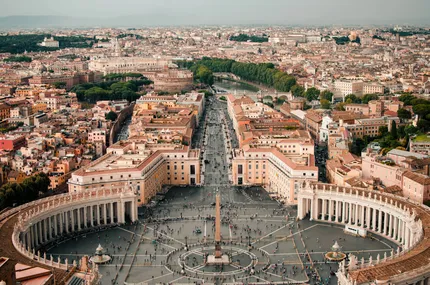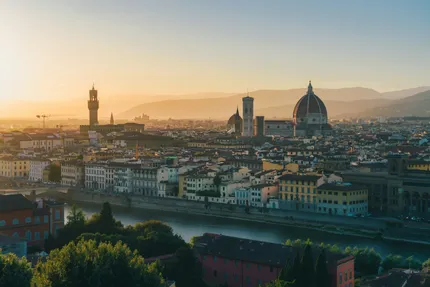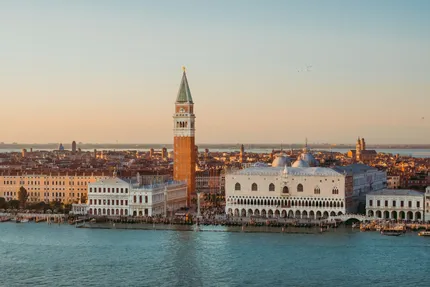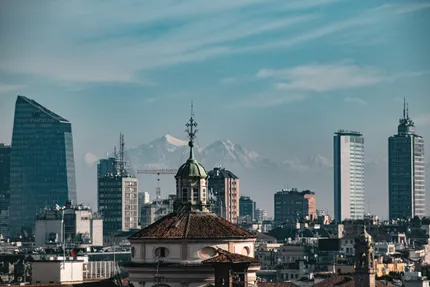CityTouring
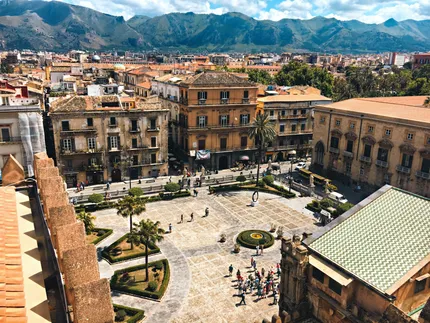
City trip to Palermo
ItalyPalermo is Sicily’s energetic capital, where Arab‑Norman palaces, Baroque churches, and faded Belle Époque façades share the same streets as buzzing markets. Start at Quattro Canti and drift to the Palermo Cathedral and the Norman Palace with its glittering Palatine Chapel, a UNESCO‑listed highlight. Teatro Massimo anchors the cultural scene with opera, concerts, and tours. In Kalsa and around Via Maqueda, balconies overflow with plants and laundry while cafes spill onto piazzas. The city is famous for street food: panelle, arancini, sfincione, crocchè, and cannoli are easy to sample at Ballarò, Capo, and Vucciria markets.
For fresh air, stroll the seafront at Foro Italico or head to Mondello’s sandy bay, a short bus ride from the center. Palermo rewards curiosity: peek into Oratorio di San Lorenzo’s stuccoed interior, climb church terraces for rooftop views, or detour to La Zisa’s Islamic‑influenced palace. Practicalities are straightforward—most sights cluster in the old town, public buses and suburban trains cover longer hops, and prices remain friendlier than in northern Italy—though traffic is hectic, and walking shoes are essential.
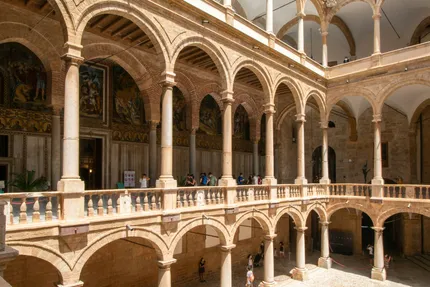
Norman Palace & Palatine Chapel
Seat of Sicily's parliament and jewel of the UNESCO Arab-Norman route, this royal palace houses the dazzling Palatine Chapel, famous for 12th-century gold mosaics and a carved muqarnas ceiling. Tour royal apartments and courtyards, then step onto terraces for city views. Buy combined tickets early; chapel occasionally closes during parliamentary events.
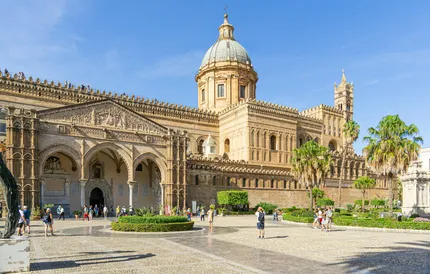
Palermo Cathedral & Rooftops
An architectural palimpsest blending Norman, Gothic, and Baroque, the cathedral guards imperial tombs, a treasury, and crypts. Climb the rooftop walk for sweeping views of domes, Monte Pellegrino, and the old city. Expect queues in peak hours; modest dress and separate tickets for rooftops and treasures are required. Audio guides are available.
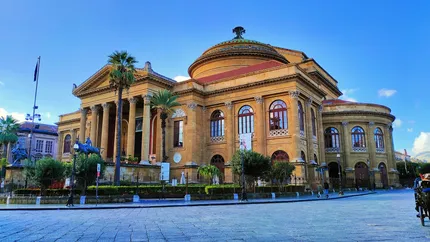
Teatro Massimo
Italy's largest opera house impresses with perfect acoustics, lavish neoclassical interiors, and monumental steps featured in The Godfather Part III. Join a guided tour to see the auditorium, royal box, and rooftop terrace, or book an evening performance. Check schedules ahead; dress codes are relaxed but smart casual fits most evenings.
Palermo suits travelers who want dense culture, food, and some seaside time in a compact radius. History and architecture fans can focus on the Arab‑Norman UNESCO ensemble—Palatine Chapel, Cathedral, San Cataldo, Martorana—and add Baroque oratories (San Lorenzo, San Domenico) and the grand Teatro Massimo. Food‑motivated visitors will thrive on street‑food walks through Ballarò and Capo, trattorie in the Kalsa, and pastry stops for cannoli and cassata; prices make grazing easy on a short break.
Urban beachgoers who prefer a city base can split days between museums and Mondello’s lidos or the rocky coves of Addaura. Curious travelers with a high tolerance for the vivid and imperfect will appreciate market noise, graffiti, and scooter‑dense streets; those seeking polished resort calm should look elsewhere along the coast. Active sightseers can hike or taxi up Monte Pellegrino for views and the Sanctuary of Santa Rosalia, then descend for sunset aperitivo in Piazza Sant’Anna. Night owls will find inexpensive bars and late street life around Vucciria and Piazza Caracciolo.
Families do well with open spaces at Foro Italico and Parco della Favorita and simple foods that kids recognize. Palermo is also practical for budget‑minded solo travelers: guesthouses are plentiful, public transport and rideshares cover basics, and most headline sights are walkable within two to three days. Art lovers can pair Byzantine mosaics with contemporary shows at Palazzo Riso and seek murals in the Kalsa and Borgo Vecchio.
Three top reasons for a city trip to Palermo
- Explore Palermo’s Arab-Norman UNESCO heritage: Cathedral’s stratified styles, Palazzo dei Normanni’s Palatine Chapel mosaics, Martorana, San Cataldo’s red domes, Quattro Canti crossroads, Kalsa alleys, and Teatro Massimo—history animating vibrant streets.
- Feast through Palermo’s markets: Ballarò, Capo, and Vucciria. Bite arancine, sfincione, panelle, and pane ca’ meusa; finish with cannoli or cassata. stops include Antica Focacceria San Francesco and Pasticceria Cappello.
- Combine city and sea: sun on Mondello’s crescent beach, hike Monte Pellegrino to Santa Rosalia Sanctuary overlooks, snorkel Addaura’s coves, then aperitivo on Foro Italico, Kalsa waterfront, at golden-hour sunset.
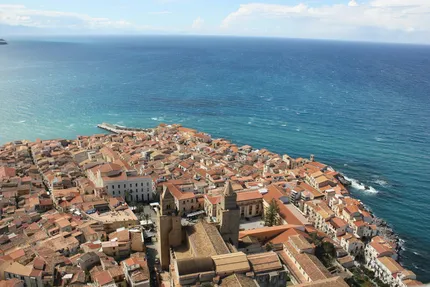
Best time to visit Palermo
April to early June and late September to October are ideal. Days are warm, skies are clear, and the sea is swimmable without the extreme heat and crowds of July–August. Spring brings longer daylight for sightseeing and green slopes on Monte Pellegrino; autumn offers pleasant bathing in Mondello and lively markets without cruise‑ship peaks. Winter is mild (10–16°C) and good for museums and food, but rain is more frequent and some beach services close. If you’re heat‑tolerant, July’s Festa di Santa Rosalia fills the city with processions and fireworks—book accommodation early and plan midday breaks.
More activities and things to see in Palermo:
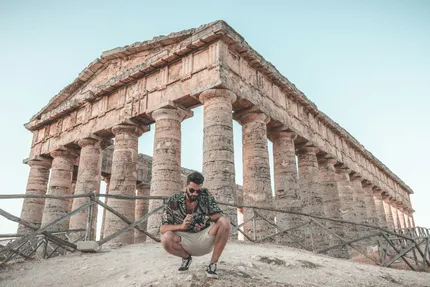
Doric Temple of Segesta
Doric Temple of Segesta, about an hour west of Palermo, is a well-preserved late 5th‑century BCE, yet unfinished, Elymian‑Greek sanctuary. Its 36 unfluted Doric columns stand roofless on a hill amid rural scenery. The Segesta Archaeological Park also includes a hilltop theater with sweeping views. Popular as a half‑day trip from Palermo.
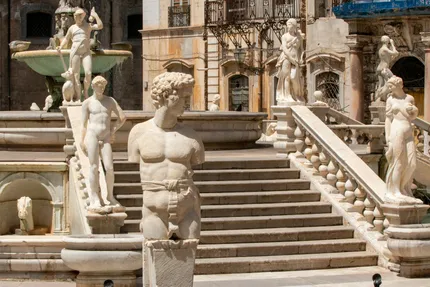
Quattro Canti & Piazza Pretoria
At the baroque heart of Palermo, Quattro Canti's scenographic facades mark the crossroads of Via Vittorio Emanuele and Via Maqueda. Steps away, Piazza Pretoria's dramatic fountain features mythic statues. Come early for photos, then explore nearby churches and cafes. Traffic circulates around the junction; watch crossings carefully. Evenings bring lively street performers.
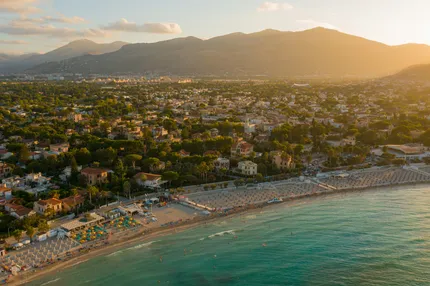
Mondello Beach
Palermo's city beach offers pale sand, turquoise shallows, and Liberty-style architecture on the historic pier. Reachable by bus, taxi, or bike, it's crowded in summer; early or late visits are best. Portions are free, others are lidos with facilities. Nearby restaurants serve seafood; sunset light is superb. Check jellyfish reports in season.
Martorana and San Cataldo (Piazza Bellini)
On Piazza Bellini, the Martorana dazzles with Byzantine mosaics, while neighboring San Cataldo shows austere Arab-Norman forms with red domes and geometric stonework. Tickets are separate. Visit in daylight to appreciate interiors and stained glass. Combined with nearby churches, it makes a compact, rewarding architectural circuit. Short queues are common; modest dress advised.
Capuchin Catacombs
A macabre, sobering site, the catacombs display thousands of naturally mummified Palermitans from the 16th to early 20th century, arranged by status and profession. Photography rules vary; respect signage and decorum. Temperature is cool underground. Combine with nearby Zisa or Monreale bus connections; children may find it unsettling. Opening hours are limited afternoons.
Monreale Cathedral & Cloister
A short bus or taxi ride uphill, Monreale's cathedral is famed for vast golden mosaics culminating in a serene Christ Pantocrator. Don't miss the Romanesque cloister's carved capitals and playful fountain. Terraces offer valley views. Plan around services; separate tickets apply for cloister and rooftop passages. Shops and cafes line the approach.
Zisa Palace (La Zisa)
This 12th-century summer palace exemplifies Islamic-influenced engineering, with cooling airflows, muqarnas, and a reflective pool aligned for breezes. Part of the Arab-Norman UNESCO circuit, it houses Islamic art and artifacts. The surrounding garden is pleasant for a brief rest. Check maintenance closures; interior can be sparsely furnished. Combined tickets sometimes include La Cuba.
The Cala & Foro Italico Promenade
Stroll the revamped harbor and seafront lawns for breezes, views, and an easy break from sightseeing. Popular for aperitivo, runners, and families, the area links the Kalsa quarter with the marina. Bike lanes and benches abound. Evenings are lively; keep an eye on belongings during crowds. Sunset boat tours depart nearby.
Ballarò Market & Street Food
Palermo's rowdiest market thrums with vendors' abbanniate calls, fresh produce, seafood, and irresistible street food: arancine, panelle, sfincione, and stigghiola. Best visited mornings; keep valuables secure in crowds. Tasting stalls are inexpensive, and nearby churches reward quick detours. Some stands close after lunch; Saturday is busiest and most atmospheric. Sundays can be quieter.
Getting around in Palermo
Palermo’s historic center is compact and very walkable, though pavements can be uneven and summers hot. The old town has a ZTL (limited traffic zone) enforced by cameras; avoid driving inside unless you have a permit. AMAT runs extensive city buses and four modern tram lines; service is frequent on main corridors but can be delayed by traffic. Buy and validate tickets via the AMAT app, kiosks, tobacco shops, or on board where available; day passes are good value. The metropolitan railway connects key districts and the airport to Palermo Centrale and Notarbartolo, useful to bypass congestion. Licensed taxis and app-based rides are widely available at stations and sights. Cycling is improving with bike lanes and the BiciPA bike-share; waterfront routes are pleasant, but traffic requires caution. E-scooter sharing operates in central areas. Parking is scarce, and local driving is assertive; a car is unnecessary in town but handy for day trips to Monreale, Cefalù, Segesta, or beaches.
Getting to Palermo
Palermo’s main gateway is Falcone Borsellino Airport (PMO) at Punta Raisi, about 35 km west. A frequent airport train (every 15–30 minutes) links PMO with Palermo Centrale and Notarbartolo in 50–60 minutes; the Prestia e Comandè bus runs every 30 minutes to the center, with taxis and shuttles also available. PMO has year‑round flights to Rome, Milan, Bologna, Venice, Naples, and strong European links to London, Paris, Brussels, Munich, Frankfurt, Zurich, Geneva, Barcelona, Madrid, and Berlin, plus many seasonal routes on Ryanair, easyJet, Wizz Air, ITA Airways, and others. Trapani (TPS) is an alternative airport. By rail, Trenitalia InterCity and overnight IC Notte connect Palermo with Messina, Villa San Giovanni, Naples, and Rome via the Strait ferry; onward high‑speed and international trains are easy from Rome or Milan. Long‑distance buses (FlixBus, Itabus) run to Catania, Messina, Syracuse, Agrigento, and to mainland hubs with through tickets and overnights. Ferries from Palermo’s port sail to Naples, Civitavecchia (Rome), Genoa, Livorno, Cagliari, and Tunis.
